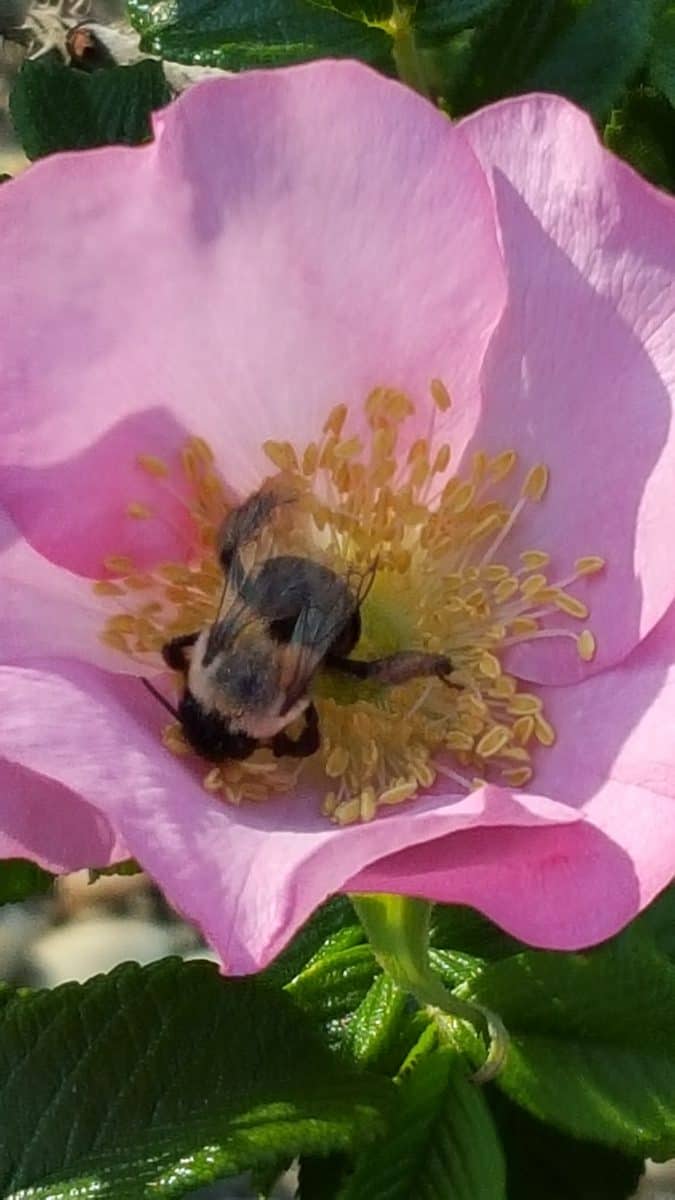
Caring for roses can be tricky, but worth the effort. Roses are the gardener’s flower, and have been since ancient times. They entice us with their fragrance, their aroma, their beauty, and their ability to grow in nearly every corner of the world. Even in the cold regions of Canada you can find wild roses growing.
So why do we love roses so much?
If I had to answer, I would say that it comes from their thorns. Thorns you ask? Yes, because they have thorns, yet such a wonderful flower we want to have them, to experiment on them, to grow them despite their thorns. The thorns make it harder to enjoy them, yet it is because of them that we DO enjoy them.
How do we care for the roses we have?
By sorting rose care into categories we can begin to plan out our year of attack on the pests and problems. Other members of the rose family also have a host of issues. Apples are in the rose family and have almost as many pests and diseases as the rose.
Let me delve into the following 4 categories to show you how caring for roses can make the best rose of the season, with limited chemical use. Being an organic gardener, I do my best to limit chemicals on all my plants, roses included.
- Pruning
- Fertilization
- Insect Pests
- Diseases
Let me jump right in!
When is the best time to prune back roses?
This all depends on the type of rose you have. There are 4 types of roses that I will discuss here: Shrub, Climbing, Hybrid Tea, and Carpet. These are what the majority of you have, and what I see the most in landscapes around the Midwest and Great Plains.
When do I prune shrub roses?
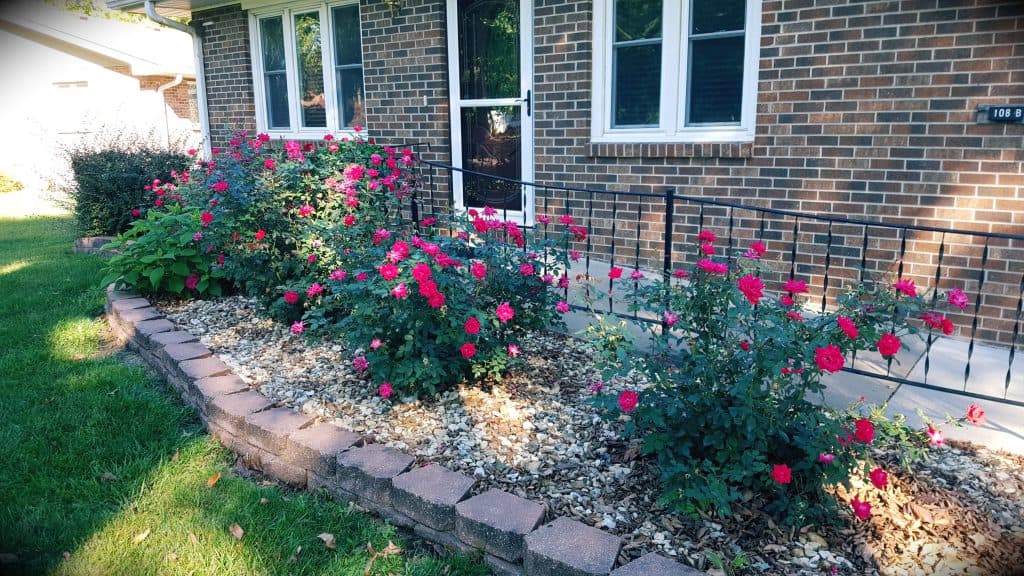
Shrub roses bloom on new growth in late spring through late summer. Pruning of these roses is best done in early spring here in Zone 5 and northward. I usually start pruning roses in late February to Early March and continue until early May. As a landscape professional, I have some 70 customers to take care of and pruning all their roses takes time.
Shrub roses should be cut back to a live bud on a cane that is about 1/2 inch in diameter. Cut the canes down to 8 to 16 inches in height. Dead canes can be cut back near the soil level, or snapped off. Remove spindly canes completely.
When do I prune climbers?

Climbing roses set their flower buds on the previous season’s growth and therefore, should not be pruned back until after the summer’s blooms have finished. Most climbing roses bloom heavy in summer, then are done for the rest of the year.
You can prune climbing roses back in spring to shape them, but heavy pruning will remove all their flower buds.
When do I prune hybrid teas?

Hybrid tea roses produce flowers on new growth, so they should be pruned in early spring. While many think that they are not hardy enough for Zones 4 and 5, this is misleading. I have never had a hardiness issue with hybrid teas, just a pruning issue with those wanting to prune in fall, or pruning too short.
Most hybrid teas are grafted onto a vigorous rootstock, and it is this rootstock that needs to be maintained carefully. If you prune below the graft union, you can kill the desirable top and will get an uninviting wild rose. Prune hybrid teas similar to shrub roses, cutting them back to 8 to 16 inches in height.

When do I prune carpet roses?
Carpet roses may be the strangest thing in rose growing I have ever seen. In most years, the only cutting they require is to prune off shoots that jut out above or away from the main structure. After bad winters, the tops of some carpet roses will die back to the ground, and need to be pruned completely off.
I use hedge shears to shape the form of carpet roses, in early spring or late winter, when I can get to the plants. Just shape them as much as you want, they will fill back in.
How should I fertilize my roses?
I will group all the roses together for this and the following parts, though many cultivars are resistant to some of the diseases. Roses are greedy plants, they like to be fed a regular supply of nutrients to maintain their health and beauty. For an organic gardener, their are several things I can do without delving into chemical applications.
Coffee Grounds, Banana peels, and Compost
Coffee grounds are great to add around roses during the growing season. They are high in nitrogen, which roses love. They also lower the pH of the soil slightly, which roses love because they grow best in an acidic to neutral pH soil. The best way to apply coffee grounds is to mix with water and water the rose with it, but you can also just sprinkle them around the base.
Banana peels are another great addition to the rose plant. Add un-composted banana peels around the base of the rose and cover with a light layer of fresh compost to add potassium to the plant. Potassium improves the quality of the flowers and helps the plant develop better disease fighting cells.
Compost is always a great addition to any garden plant, if it is prepared correctly. Never use any compost that is wet, stinky, or clumpy. Compost should have an earthy smell, be moist to dry, and be loose. Add compost around the base of rose plants for a boost of nutrients and to help lower the soil pH.
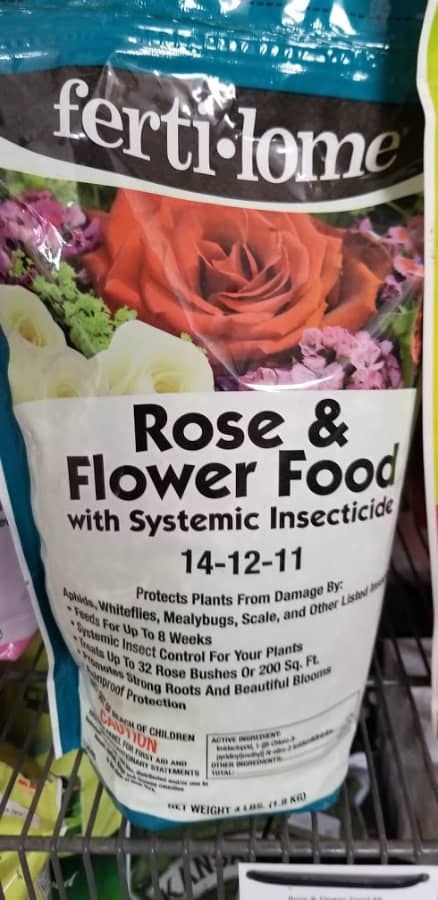
Is there any all-in-one fertilizers you recommend?
Yes, for my commercial customers I do not have the readiness of compost or coffee grounds to add around each rose, nor the time to do it. I use and recommend Fertilome Rose and Flower Food plus Systemic. This fertilizer product applies a good amount of N-P-K fertilizers plus micro-nutrients of Boron, Iron, Manganese, and Copper. The systemic insecticide in the product helps the plant fight back against aphids, mealybugs, scale, and lacebugs.
What are the insects pests I should worry about?
While there are a large number of insect pests that effect roses, I will just talk about the following 5:

- Aphids
- Japanese beetles
- Rose Slug
- Rose curculio
- Leafcutter bees
Aphids on Roses
Aphids always seem to gross people out, probably because they feed in masses and produce a sticky poop called honeydew. When there are large outbreaks of aphids, there are also a number of predators eating them. If it gets bad enough and you want to help out your roses before they get all the juices sucked out of them, use a garden hose and spray the aphids off at high pressure.

Japanese beetles
Japanese beetles have only recently become an issue here in my area, though they have been in most of the Midwest for decades. I find that handpicking works best for dealing with Japanese beetles, just go out in the evening, around 7, and knock them off into a bucket of soapy water.
Chemical sprays are not very effective, as they can take several days to kill the beetle, by then the damage is done.
And DO NOT use Japanese beetle traps! These traps have a floral lure and a pheremone to attract both male and female beetles. However, on their way to the trap (from up to 5 miles away), they eat your plants. So no traps for me or you.

Rose Slug
Actually the larvae of the a sawfly, rose slug is a common pest of roses. This insect larvae feeds on the underside of the rose leaves, causing a silvery-pattern above. If left untreated, they can defoliate an entire plant in 2 weeks.
The best treatment that I have found for this insect is an application of Spinosad, an organic chemical labeled mainly for caterpillars.
Rose Curculio
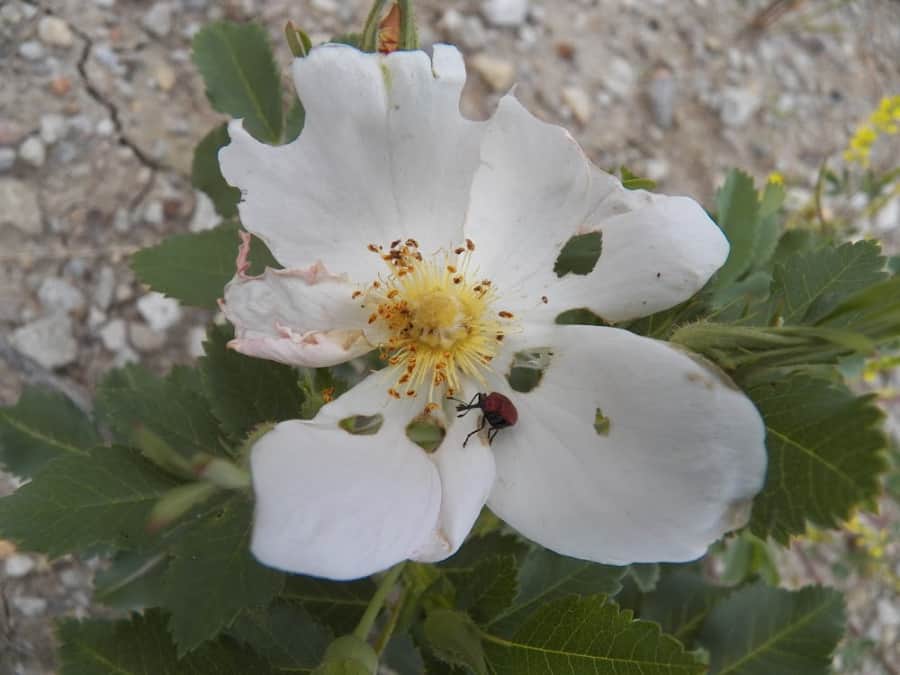

This insect pest is a weevil that feeds on the flowers and flower buds, causing large holes when the whole flowers opens wide. If you find this insect on your roses, just bring along a bucket of soapy water and drop them into it. They “play dead” when disturbed, making it easy to drop them in.
Leafcutter Bees
While leafcutter bees are not a pest that tries to eat of kill roses, they can cause large holes in the leaves of roses and other plants. I do not recommend any treatment for them, just let them have a few leaves for their nests.
What diseases should I worry about on my rose?
There are 4 major diseases of roses that I will explain as best as possible. They are:
- Rose rosette
- Rose mosaic virus
- Stem canker
- Black Spot
All of these diseases are serious problems on roses and should be addressed asap.

What is rose rosette disease?
Rose rosette is a virus that causes witch’s brooms, abnormal growth, excessive thorns, and often death of the plant. It is vectored by a tiny eriophyid mite.
There is no cure for the disease and no practical way to prevent the mite from infecting the rose. However, not all roses are infected and not all in a single planting may get it if another does. It mainly affects multiflora rose, which is a weed in the American landscape.
However, I have seen many cases of it on shrub type roses. Once the rose is infected and the symptoms develop, the only “cure” is to remove the rose and burn immediately or put into the trash. (NEVER PUT INFECTED PLANTS IN THE COMPOST). Wait 30 days, then you may replant with another rose in the same spot.

What is rose mosaic virus?
The rose mosaic virus is actually a disease caused by 2 separate viruses, the apple mosaic virus and the prunus necrotic ringspot virus. They both can affect roses with a leaf disease that causes ring spotting and bright yellow patterns in the leaves.
It is transferred to roses by grafting and budding of healthy plants onto infected rootstock. There is no cure, but it only effects the early season leaf growth, and by summer and bloom time it has gone away completely, waiting to resurface next year.
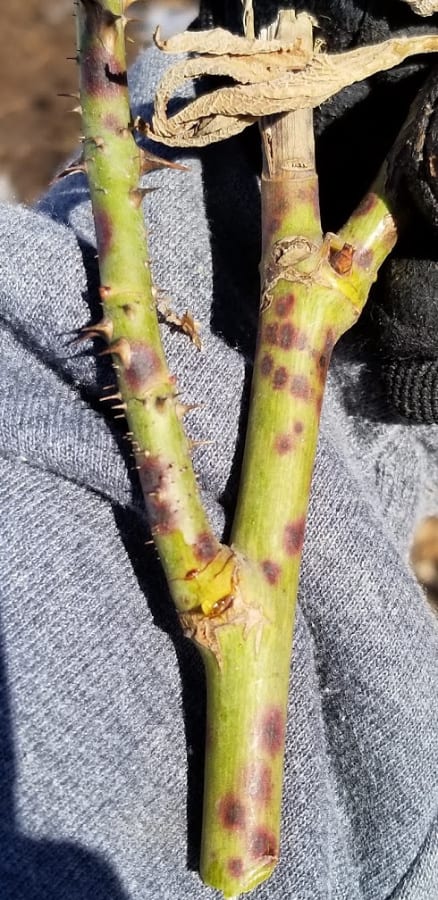
What are rose stem cankers?
Rose stem cankers are brown or reddish spotted splotches along the canes of the roses. This is a fungal disease that weakens the plant and can eventually kill the plant if left untreated. The best method for treatment is to prune out the infected canes and CLEAN your pruners in between each cut with an alcohol solution.
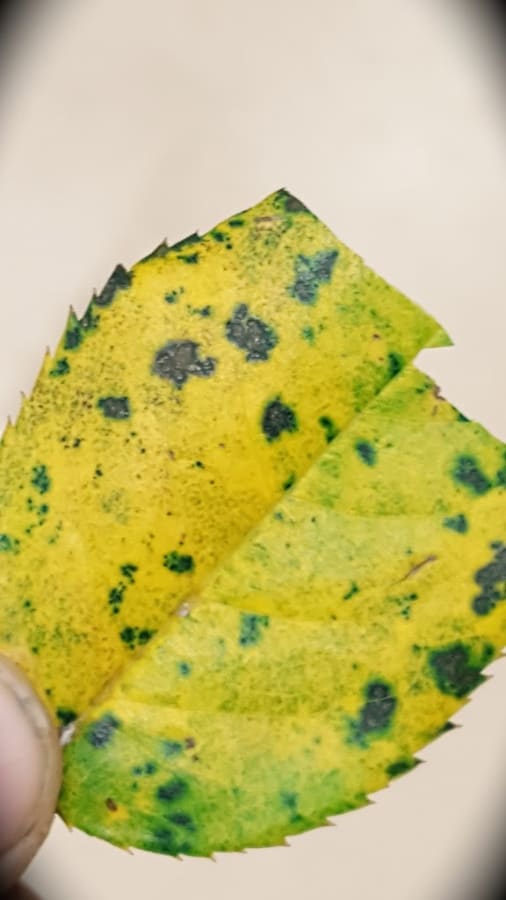
What is black spot disease?
Black spot is the most annoying disease of roses. It is a fungal disease that spreads on the leaves through rain splash in warm, wet weather. This disease weakens the plant and stays on the leaves, causing yellowing, and eventually killing leaves.
The best treatment is to plant resistant roses. If you are set on roses that may be prone to black spot or have older roses in the garden already, then the proper care is to remove any infected leaves and destroy in fire or put in the trash. Spray the plant with a fungicide such as Bonide Rose Shield.
Now that you know what care your rose needs, you should be all set for the year.




I read your blog. Having very use full information help me a lot. I will read more articles on your blog.
I have been a gardener/landscaper all my life, But am now in a situation of defeat :
I am caring for a mammoth hilltop estate
Where the owner had planted 120 pink carpet roses all over the front – streetside
without any supporting shrubbery.
They were planted 15 years ago, now there seems to be no life in them, ( even after fertilization )
(this is in coastal southern California . The surface soil seems to be rootbound – is it possible
that the neighbor’s trees are choking these Carpet Roses to death ?
Hi Craig,
That is quite the situation. How far away are the tree and what kind of trees are they? While it is possible that that is the situation, it seems more likely to me that when the original plants were put in, they were root bound in their pots, and now are succumbing to their own roots killing them. It is not a situation we see very often in shrubs, but very often in trees. Trees with circling or girdling roots, if not corrected at planting, will kill the tree in 15 to 30 years.
The best way to find out would be to dig one rose out, and see what the roots are doing. If there is a mass of twisted roots, circling among themselves, with few fine roots or root hairs, and little or no soil within the roots, then the roses are killing themselves with their own roots. Its no fault of theirs, just a common nursery problem. And there is no good way to fix it on an older plant. You can try pruning the roots back by removing up to half of the circling roots, and then replanting them with a root stimulator. Or you can dig them all out and replace them.
If you dig up the root ball and the roots are white, healthy looking, and have few to no circling or twisting roots, and roots from the trees break off or are visibly present, then that is the problem. The best remedy is to use a flat digging shovel to deep edge the bed, or if possible, a trencher along the tree side of the rose bed. Fill the hole back in with the original soil. If this is the problem, the solution will need to be repeated every 3 years to keep the tree roots from encroaching again.
I hope you will be able to save them.
Best regards,
The Kansas Gardener